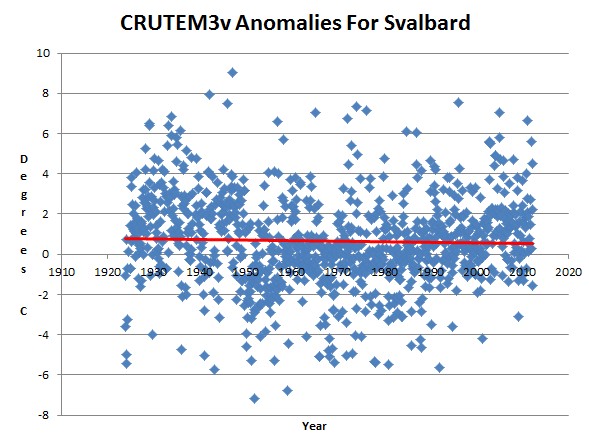According to Phil Jones, Svalbard has been cooling since the beginning of their records in 1923.
A new study from James Hansen University chooses to use proxy data, while ignoring the thermometer data.
Summers on the Norwegian archipelago of Svalbard are now warmer than at any other time in the last 1,800 years, including during medieval times when parts of the northern hemisphere were as hot as, or hotter, than today, according to a new study in the journal Geology.
Researchers produced the 1,800 year climate record by analyzing levels of unsaturated fats in algae buried in the sediments of Kongressvatnet lake, in western Svalbard.
High-Arctic Heat Tops 1,800-Year High, Says Study | Lamont-Doherty Earth Observatory
This is the reverse of Michael Mann’s approach. Mann threw out proxy data which he didn’t like, and replaced it with Hansen’s adjusted thermometer data. In this case, the researchers ignored the thermometer data, and replaced it with proxy data.



“In this case, the researchers ignored the thermometer data, and replaced it with proxy data.”
The same ‘trick’ was used to ‘discover’ the climate model’s dead-certain mid-troposphere hotspot due to carbon sewage. Ignore the balloon and satellite measurements of temperature, and instead use wind shear as a proxy for temperature.
Its just another example of pro-climateers rooting around for patterns in the tea leaves, trying to justify their end-of-the-world sandwich boards.
None of this seemed real to citizens Jane, John and Judy, as they stared at shiny bling on TV, green with envy.
So the algae disagree with the ice cores, the tree rings and the thermometer record but algae never lie. Or should I say that proxy temperature reconstructions using algae trump all previous reconstructions. It is the authors’ overweening confidence in their conclusions that is so irksome. This would be a good one for Steve McIntyre or one of the other bloggers knowledgeable about proxy reconstructions to dissect.
Sounds like Magic Numbers at work here.
The cherry on top is the revelation that the Team now recognizes the MWP did in fact exist.
A little OT, but it just occurred to me that this site is carrying out a version of the “whack-a-mole” strategy proposed by General Petraeus, I think, for dealing with jihadists in Afghanistan and elsewhere. And, of course, doing it quite effectively.
Still, it might be worth exploring the parallels in the 2 situations. As well as stepping back and thinking about the strategies that are available in this war and why one might be more effective than another.
Hansen is just more comfortable working with peers, like pond scum.
The Svalbard record is not a single record. The Svalbard record is a “spliced” dataset, meaning it is a combination of the Svalbard and Isfjord Radio records. He does not mention, and may not have known, that the location of the Isfjord Radiostation was changed three times. The station then fell into German hands during WWII, and subsequently was returned to Norwegian control at the end of WWII.
As a result, the Svalbard instrumental record is not much use for anything except ridiculous claims by Michael Mann …
w.
Greenland records show the same thing – declining temperatures for 80 years.
Thanks, Steven. Which Greenland records are you referring to? Neither of the longest records (Godthaab Nuuk and Angmagssalik) show such a decline as you say, neither one has declining temperatures for 80 years. I’m not saying you are wrong, just asking which records you are referring to.
w.
Yes they do http://stevengoddard.wordpress.com/2012/08/18/80-years-of-declining-temperatures-in-greenland/
Ah, I see, you didn’t use the whole record, just 80 yrs. My bad, poor reading skills, I should have picked up on that.
w.
Both data sets from Greenland are ‘adjusted’ by GISS. A bad route as far as I am concerned given their history of altering data sets to suite their model output. Both graphs show a cyclic change which I would expect with natural changes.